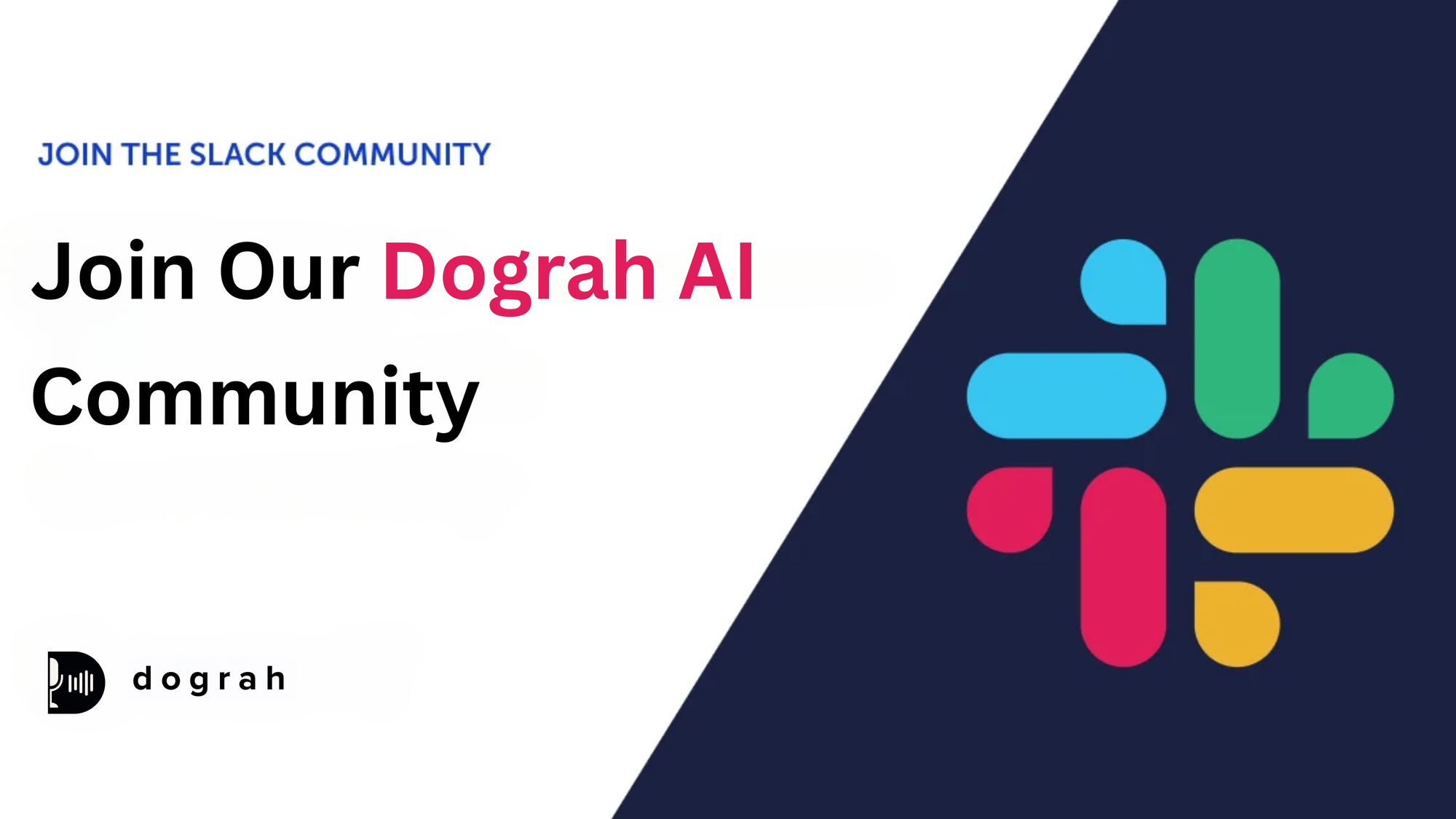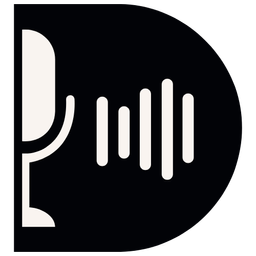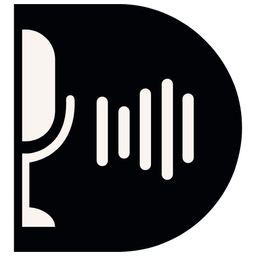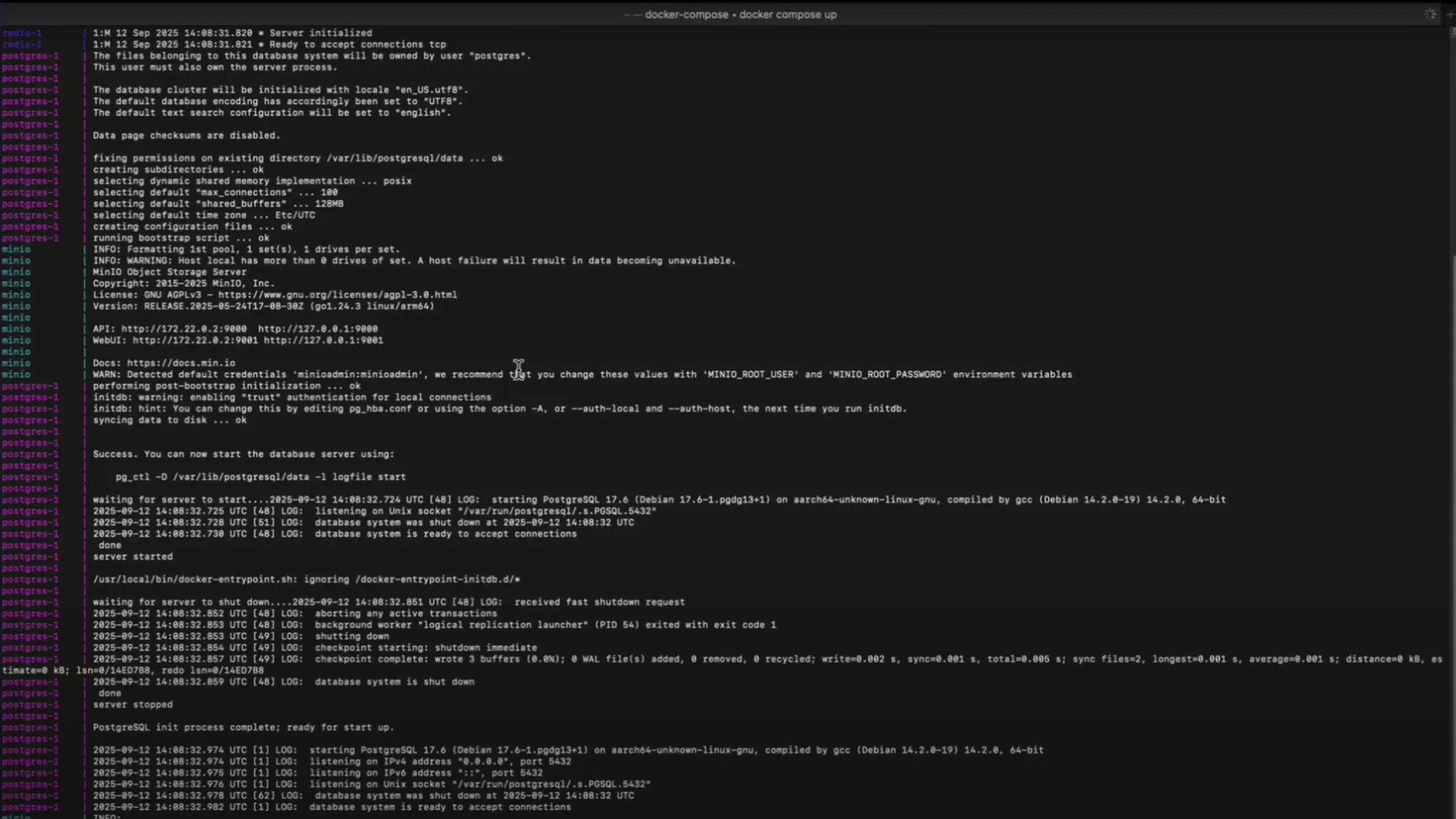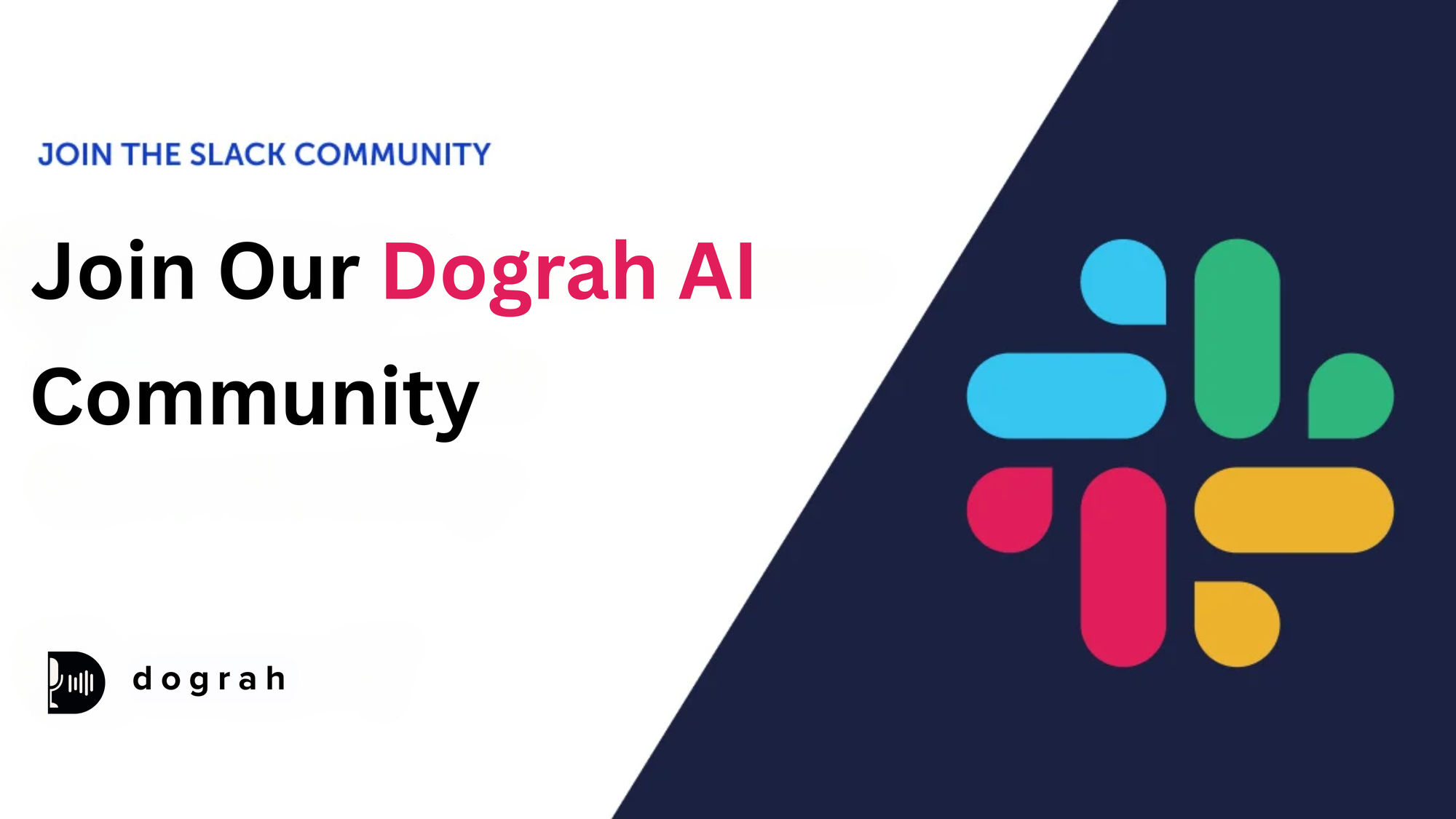Voiceflow AI Pricing Breakdown: And How Open Source Saves 70%
Voiceflow pricing includes Starter, Pro, Business, and Enterprise, all credit-based. The Starter plan is free with 100 credits, and the platform sends automatic usage alerts at 50%, 70%, 90%, and 100%. Once credits run out, agents stop working. Some Reddit users report heavy credit consumption, especially with Claude Sonnet 4. This highlights the value of open-source alternatives like Dograh AI, which is free to use and offers a broad set of features.
Voiceflow billing covers plans, editor seats, and credits, with a free tier and paid plans from $60/editor/month, scaling by features and team size.
This blog breaks down Voiceflow pricing and compares it with its top competitors, such as Dograh AI and other competitors, to help you select the best AI phone agent platform you need.
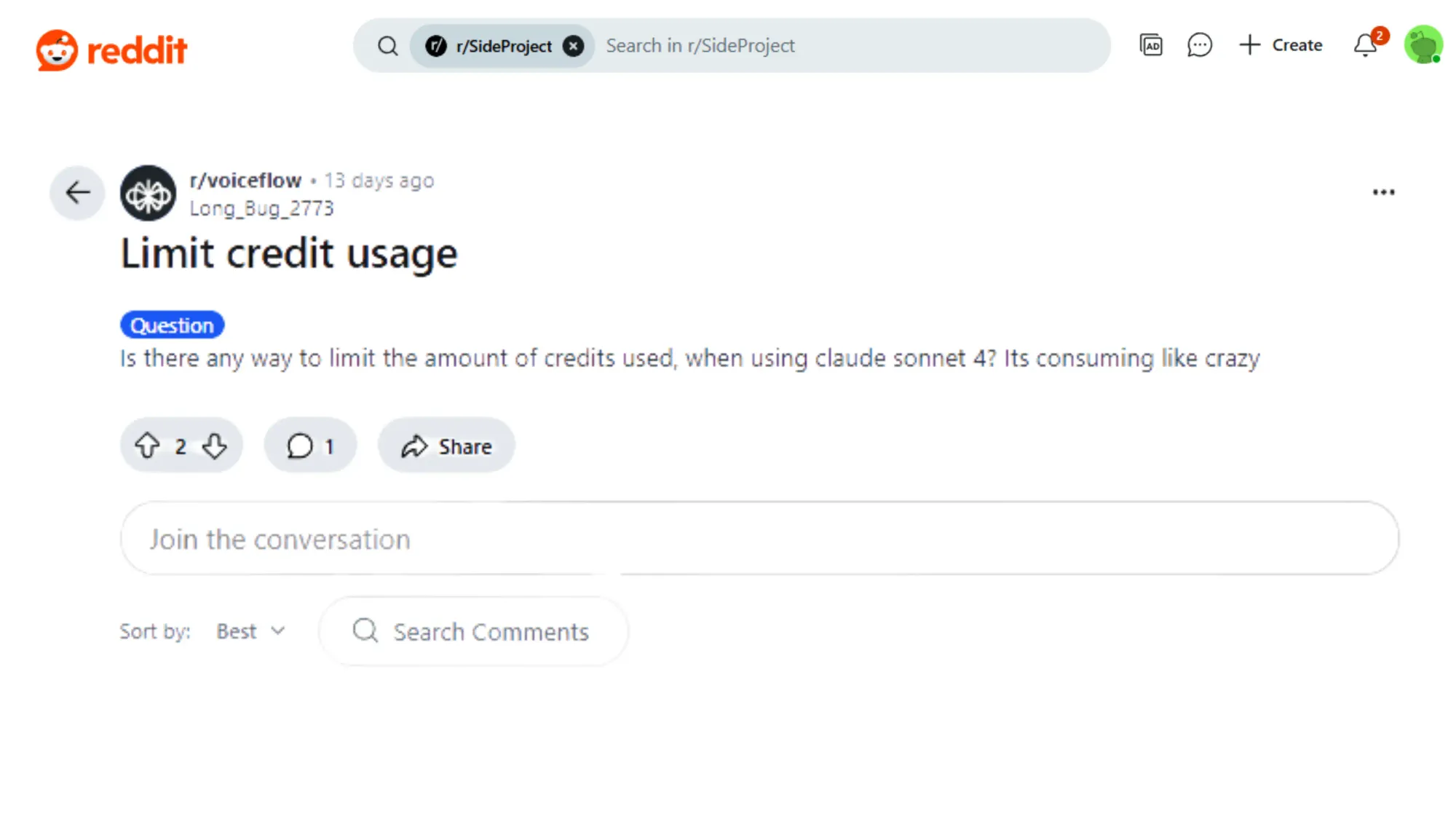

Table of Contents
- Voiceflow Pricing at a Glance
- How Voiceflow Pricing Works and Tiers Comparison
- How to calculate your monthly bill with Voiceflow
- Pros and Cons of Voiceflow Pricing
- How Voiceflow compares to Dograh
- The Bottom Line: Is Voiceflow Worth it?
- Build a free AI voice agent with Dograh Today
- Cost Optimization Strategies
- Final Thoughts
- FAQ’s
Migrate from Voiceflow: Save upto 90% time with Dograh Voice AI.
Dograh offer an open-source, no-code Voice AI builder that lets you control and deploy voice agents in minutes with reliable multi-agent conversational flows.
Voiceflow Pricing at a Glance

Voiceflow’s billing covers plans, editor seats, and usage credits. It provides a free tier for users who want to get started without cost. Paid plans start at $60 per editor per month and scale depending on the features and team size.
Core Pricing Structure
- Starter : The Starter plan is designed for students and hobbyists and is completely free. It includes 100 credits, 1 workspace, 50 knowledge sources, basic LLM models, 2 agents, 1 concurrent voice call, 1 test user persona, and access to Large Language Models like ChatGPT. This plan provides everything needed to experiment and build small-scale projects.
- Pro : The Pro plan is aimed at individual builders and costs $60 per month, with a 7-day trial. It includes 10,000 credits, 2 workspaces, 3,000 knowledge sources, all LLM models, up to 20 agents, 5 concurrent voice calls, and 5 test user personas. Users also get access to all major Large Language Models, including OpenAI and Anthropic, making it ideal for advanced personal projects.
- Business : The Business plan is designed for growing teams and costs $150 per month, with a 7-day trial to get started. It offers 30,000 credits, 5 workspaces, 10,000 knowledge sources, LLM fallback models, unlimited agents, priority support, 15 concurrent voice calls, custom widget privacy, and unlimited test user personas. Teams also get access to all major LLMs, including OpenAI and Anthropic, making it ideal for scaling complex projects.
- Enterprise : The Enterprise plan is built for organizations scaling at volume and is billed annually with custom pricing via invoice. It includes unlimited product usage, Agent CMS, custom and private cloud options, dedicated training, professional and migration services, custom LLM support, and custom contracting. Additional features include custom widget privacy, user management, and Single Sign-On (SSO) for secure, large-scale deployment.
How Voiceflow Pricing Works and Tiers Comparison
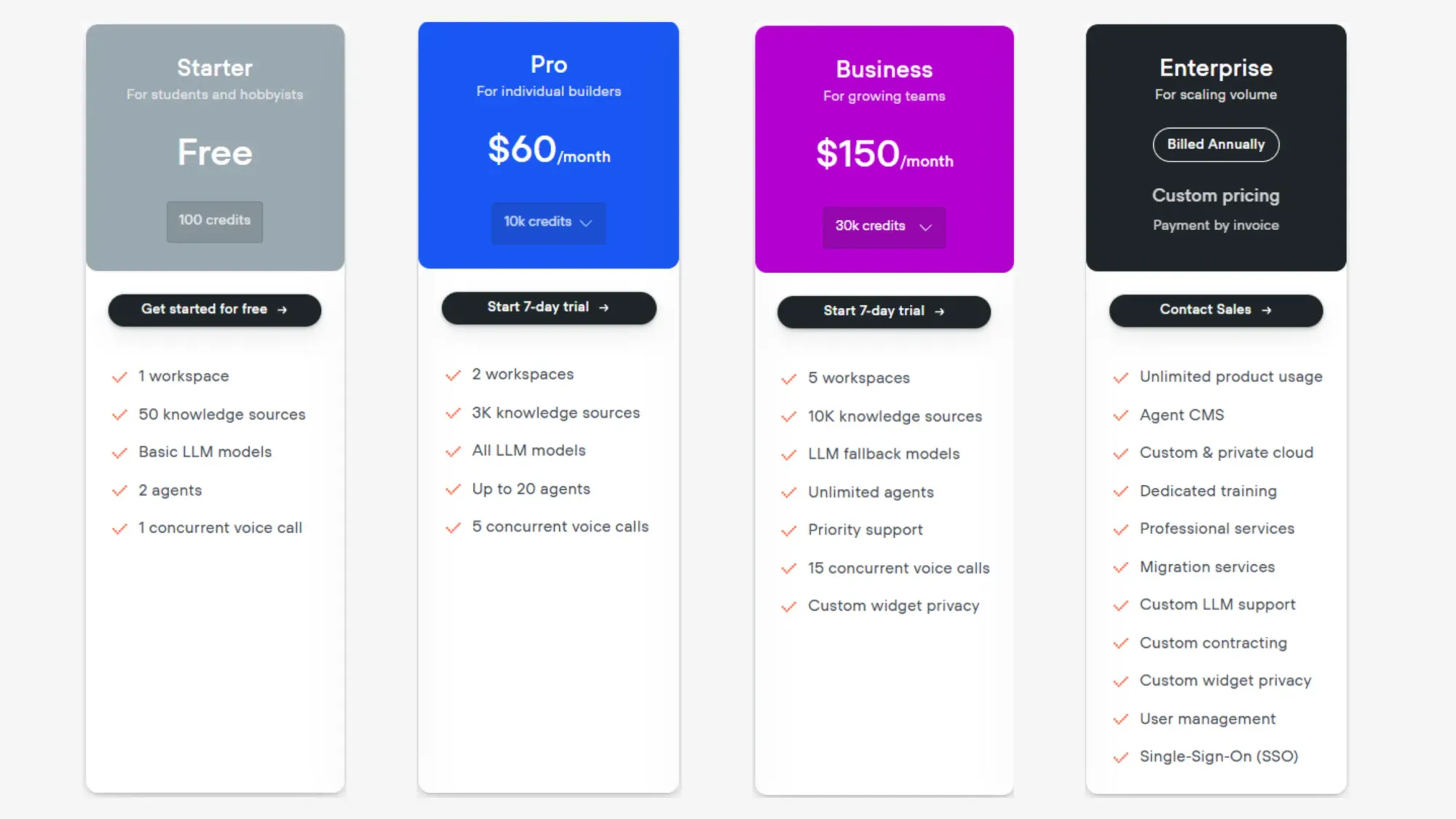
Voiceflow’s pricing depends on three key factors: chosen plan or tier, number of paid editor seats and usage credits. Here’s an overview of how the model works and how the main 2025 tiers compare.
How Voiceflow Pricing Works
Voiceflow offers a flexible and transparent billing system designed to accommodate teams of all sizes.
There are three aspects to Voiceflow's billing system that you should be aware of:
- Plans : these are billed as a monthly or annual subscription per workspace, and control which Voiceflow features you have access to.
- Editor Seats : all plans include one editor seat. Additional editor seats can be added onto any paid plan.
- Credits : these are how you're billed for usage on Voiceflow. Each plan includes a specified amount of credits. You cannot buy additional credits outside of upgrading your plan.
Editors Seats : Every Voiceflow plan includes one editor seat, allowing a single user to edit all agents within a workspace. For team collaboration, extra editor seats can be added at a fixed cost of $50 per editor on Pro and Business plans. Each seat grants access to all agents in the workspace, with the option to limit editors to specific projects if needed.
Credits : Credits serve as the currency for Voiceflow billing, with each plan providing a specific allotment. Agents consume credits when performing actions such as sending messages, making phone calls, or generating text using AI. Usage beyond the included credits may require purchasing additional credit packs.
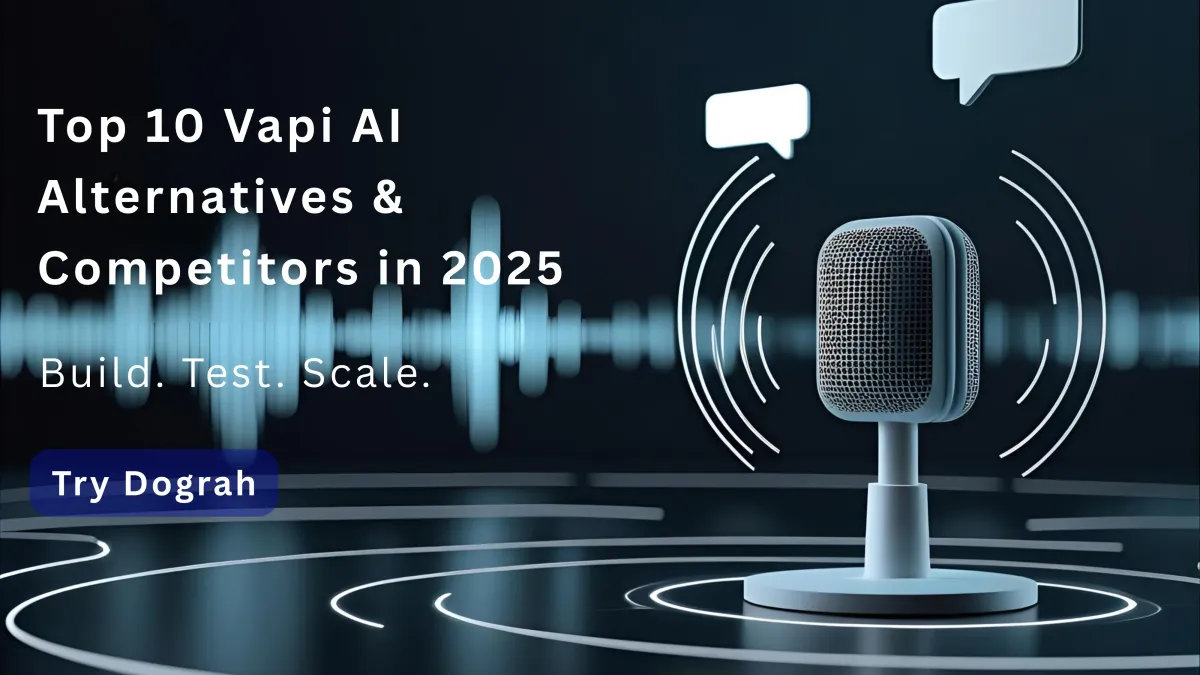
Top 10 Vapi AI Alternative & Competitors in 2025
Voiceflow Pricing and Tiers Comparison
Why Voiceflow uses credits
Voiceflow uses a credit system to simplify payment for Agent hosting and AI services (LLMs, TTS, STT), avoiding vendor lock-in or surprise bills.
- No extra accounts are required : Models from OpenAI, Anthropic, Google, Meta, and more are available through one Voiceflow account.
- Vendors can be switched anytime : As pricing or quality changes, providers can be swapped without rewriting agents or renegotiating contracts.
- Costs are transparent : Every action has a clear credit cost, while most non-AI logic (like API calls or steps) is free.
- Volume discounts apply : Voiceflow negotiates bulk rates with AI vendors and passes the savings directly to users.
What happens if Voiceflow runs out of credits ?
Voiceflow provides automatic usage alerts at 50%, 75%, 90% and 100% of the credit limit. When credits run out, the agent stops working. To prevent outages, users are advised to monitor credit usage and upgrade to a tier that meets their needs, with the option to downgrade at any time.
Real Cost Breakdown
The voice agents and chat agents are billed differently by Voiceflow due to their operation here’s breakdown :
Chat agents
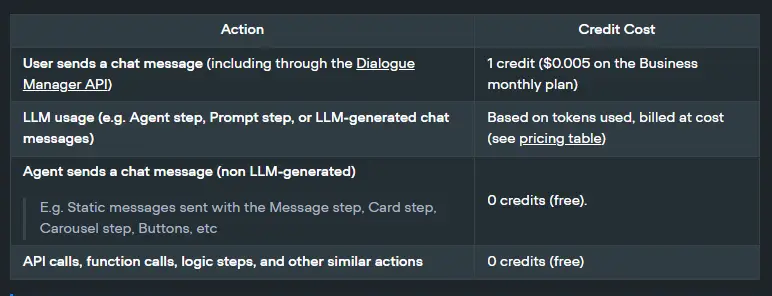
Here’s how chat agent works in practice for a five turn conversation:
- User sends 5 messages = 5 credits
- Agent sends 15 messages + 3 API calls = 0 credits
- LLM usage - GPT-4o Mini = ~1 credit
Total : 6 credits ($0.03 on the Business monthly)
Voice agents
Voice agents are billed per minute, plus text-to-speech, speech-to-text, and LLM usage. Telephony rates (such as renting a phone number and connection fees) are charged directly by our supported providers: Twilio and Vonage.

Here’s an example of how voice agent works in practice for a five minute conversation:
- Agent talk time (5 min x 10 credits per minute) = 50 credits
- LLM usage - GPT-4o Mini = ~1 credit
- Text-to-Speech - ElevenLabs Flash (2.5 min, ~2,140 chars, 9 credits per 1,000 characters) = 20 credits
- Speech-to-Text - Deepgram Nova 3 - (5 min x 1 credit per minute) = 5 credits
Total : 76 credits ($0.38, or $0.076 per minute on the Business monthly plan)
Setup and Technical Needs
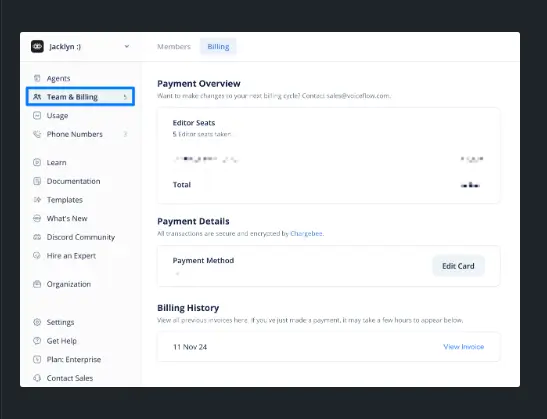
Voiceflow’s pricing and technical requirements demand careful planning, as costs combine plan tiers, per-editor fees, and credit-based usage, scaling with team size and project complexity. Building agents on Voiceflow includes designing visual flows, structuring logic, integrating APIs, testing, and deploying to channels like web, phone, or messaging platforms.The no-code interface works well for simple use cases, but advanced projects often need developer support for custom modules, API integrations, and automation.
Knowledge base structuring and deployment workflows also play a key role in scaling agents effectively. For phone connections (IVR/telephony), external services like Twilio are required, along with API keys to link with Voiceflow.Since all runtime usage AI responses, API calls, and telephony minutes, consumes credits, estimating customer traffic and features is essential for monthly budgeting.
How to calculate your monthly bill with Voiceflow
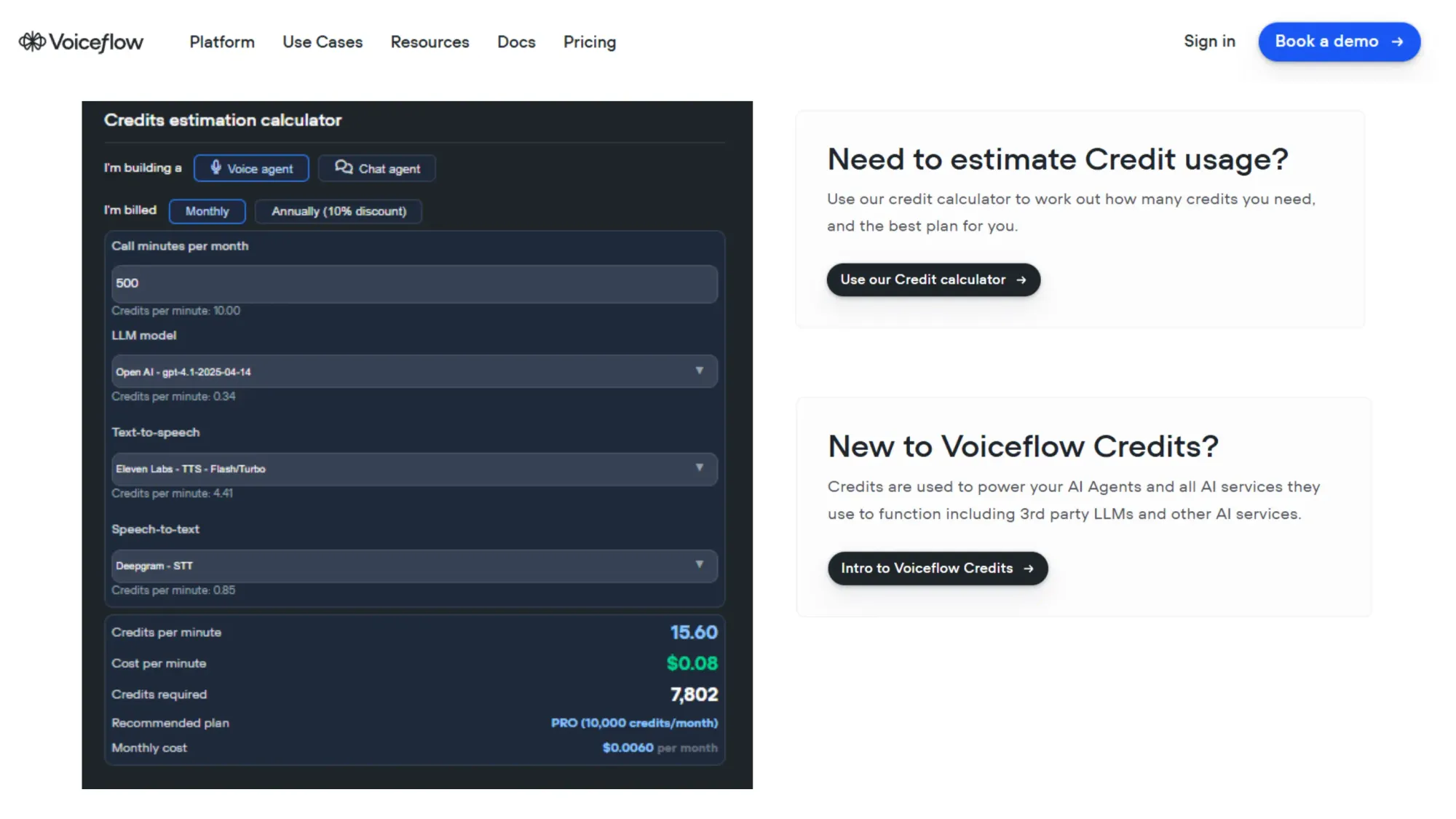
Using the credits estimation calculator, a project requiring 500 call minutes per month would consume 10 credits per minute, totaling 7,802 credits. This setup leverages OpenAI GPT-4.1 for LLM, Eleven Labs for TTS, and Deepgram for STT, with an estimated cost of $0.08 per minute (15.6 credits). Based on this usage, the recommended plan is Pro, offering 10,000 credits per month at $60, which comfortably covers the requirement.
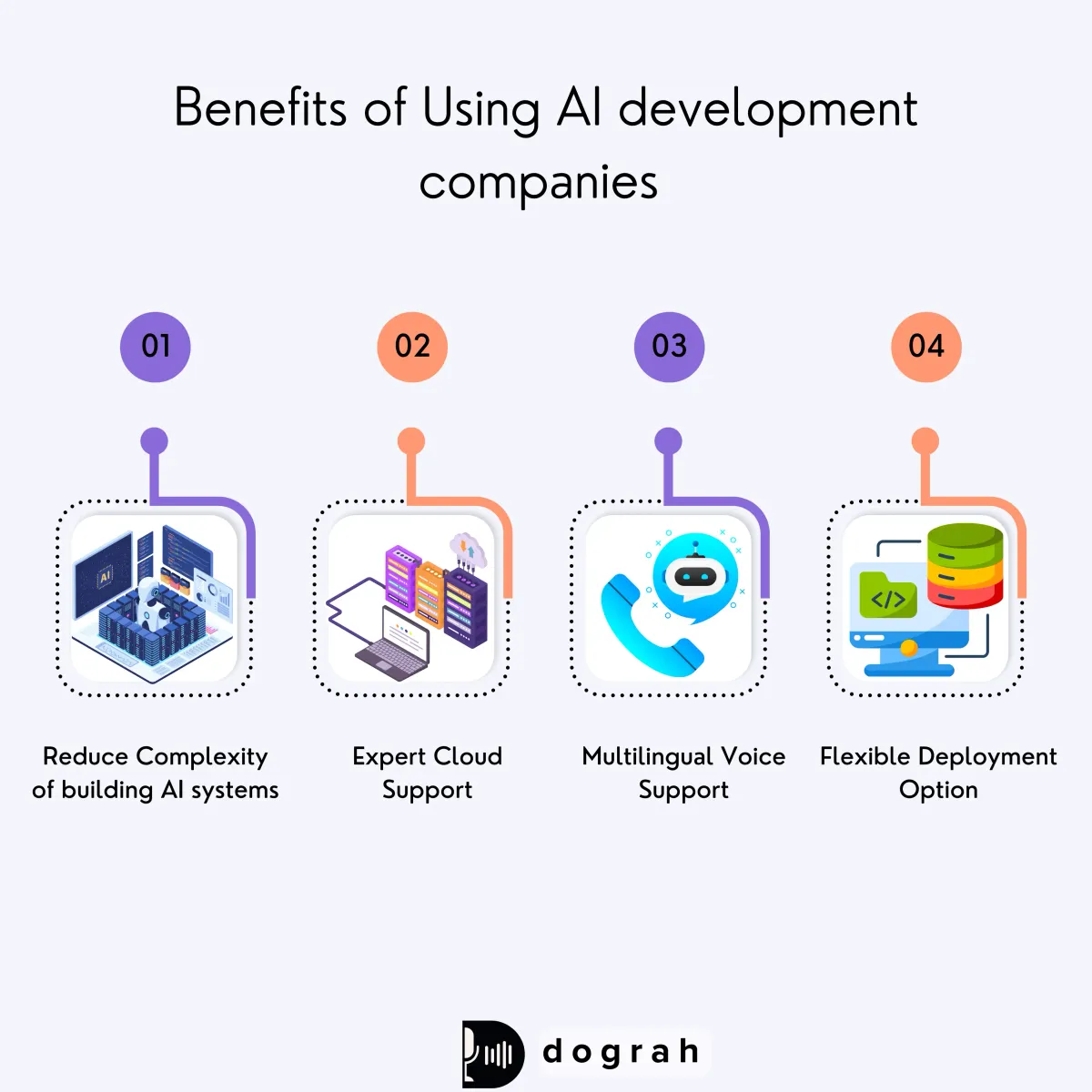
Top 10 Voice AI Calling Development Companies
Pros and Cons of Voiceflow Pricing
Pros
- Free Starter plan : Allows solo builders and hobbyists to experiment for free, with 1 concurrent voice call and up to 50 knowledge sources.
- Flexible usage-based billing : Monthly credit usage ties costs directly to actual agent activity and traffic levels.
- Editor-only billing : Free viewer seats allow stakeholders to collaborate without adding extra builder costs.
Cons
- Unpredictable Costs : Credit-based billing can cause expenses to spike during heavy traffic or sudden usage surges, making it difficult to budget accurately for peak periods.
- Functional Limits by Plan Tier : Starter and Pro plans place caps on agents, calls, and features, while advanced needs like SSO, compliance, and higher call volumes require upgrading to Business or Enterprise tiers.
How Voiceflow compares to Dograh AI
Dograh offers an open source solution without any platform charges. This makes it more cost-effective, customisable and scalable compared to Voiceflow.
What Dograh AI offers that Voiceflow doesn’t
The Bottom Line: Is Voiceflow Worth It ?
Voiceflow is great for teams that want an easy way to design and test chatbots quickly. It’s simple to use, good for teamwork, and helps with fast updates. But it may not be the best choice if you need large-scale voice automation, detailed analytics, or quick live support setup.
Migrate from Voiceflow: Save upto 90% time with Dograh Voice AI.
Dograh offer an open-source, no-code Voice AI builder that lets you control and deploy voice agents in minutes with reliable multi-agent conversational flows.
Getting started with Dograh
Interested in leveraging Dograh for lead generation, cold calling or business automation ? Here’s a streamlined path to getting started, along with direct links to essential resources :
1. Dograh AI: Quick Start Demo
2. Run Docker Command
Download and Start Dograh first startup may take 2-3 mins to download all images
3. Quick Start Instructions
How to Build AI Voice Agent - Step by Step with Dograh
Step by step written guide to building and deploying your first voice AI Agent
- Open Dashboard: Launch http://localhost:3000 on your browser.
- Choose Call Type: Select Inbound or Outbound calling.
- Name Your Bot: Use a short two-word name (e.g., Lead Qualification).
- Describe Use Case: In 5–10 words (e.g., Screen insurance form submissions for purchase intent).
- Launch: Your bot is ready! Open the bot and click Web Call to talk to it.
4. Community & Support
Join Slack Community and discuss issue with Dograh experts :
5. Additional Resource
Cost Optimization Strategies
Voiceflow bills LLM and TTS usage at cost, without profiting from these features, and passes any bulk discounts from providers directly to users. Consequently, it is in their interest to help optimize agents to use the fewest credits possible. Note users cannot auto-upgrade for credit tiers. Credits are billed differently for chat and voice agents due to their operation: chat agents run asynchronously and are less expensive, while voice agents operate in real time and incur higher costs.
Final Thoughts
Voiceflow is affordable and useful for solo creators or small teams, offering free and Pro plans, an easy editor, and credit-based pricing. But costs rise fast with extra editors, and heavy or changing usage can make bills unpredictable. Bigger teams may also need developers for integrations, adding extra expenses.
Related Blog
- Discover the Top AI Communities to Join in 2025 for innovation and collaboration.
- Learn what makes Voice-Enabled AI Workflow Builders Effective in 2025.
- Discover how Making AI Outbound Calls Work: A Technical Guide for Call Centers can streamline automation and boost call efficiency.
- Explore AI Outbound Calling in 2025: What Actually Works Now to learn proven strategies for effective, real-world voice automation.
- See how 24/7 Virtual Receptionist Helps Small Firms Win More Clients by boosting responsiveness and improving customer engagement.
- Learn how How Call Automation Cuts Outbound Calling Costs by 60%: Virtual Assistant Guide can transform your call center’s efficiency and savings.
- Check out "The Ultimate Guide to Reduce Speech Latency in AI Calling [Proven]" for expert tips on making your voice agents faster and more responsive.
FAQ’s
1. How much is Voiceflow per month ?
Voiceflow offers a free tier, with paid plans starting at $60 per editor/month, scaling based on features, team size, and credit usage.
2. Is Voiceflow free to use ?
Voiceflow offers a free Starter plan with 100 credits, 1 workspace, 50 knowledge sources, basic LLM models, 2 agents, and 1 concurrent voice call, but it’s not completely free like Dograh AI.
3. Does Voiceflow use ChatGPT ?
Yes, Voiceflow uses ChatGPT as one of its supported LLM models, allowing users to integrate OpenAI’s GPT for conversational AI.
4. Is voice AI fully free ?
Voice AI is not fully free on platforms like Voiceflow, but Dograh AI is fully free and open-source, offering 2-minute launches, prebuilt templates, and AI-to-AI testing.
5. What is the best free AI assistant ?
The best free AI assistant depends on needs, but Dograh AI stands out as fully free, open-source, and ready for fast 2-minute launches with prebuilt templates and AI-to-AI testing.
6. Which is better, Voiceflow or Botpress ?
Botpress for advanced customization and enterprise-level needs, and Voiceflow for rapid deployment and user-friendly design.
7. What are the limitations of Voiceflow ?
Voiceflow has some limitations, including issues with logging transcripts, which can make debugging and performance analysis difficult. It also experiences large credit consumption, especially with advanced LLMs and Twilio integration can be complex to set up and maintain.
8. Why are AI chatbots so expensive ?
AI chatbots are expensive because of LLM usage, real-time processing, cloud infrastructure and maintenance costs, but alternatives like Dograh AI are fully free.
Was this article helpful?

